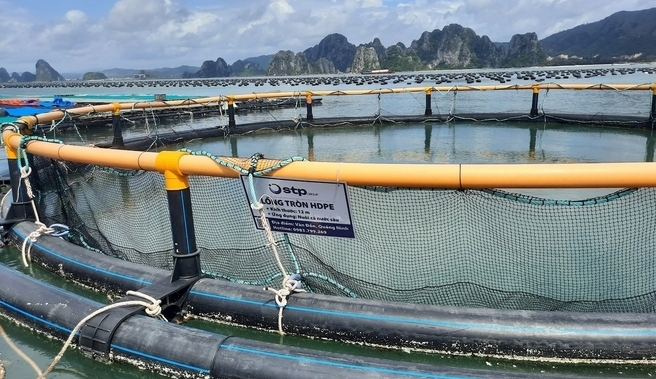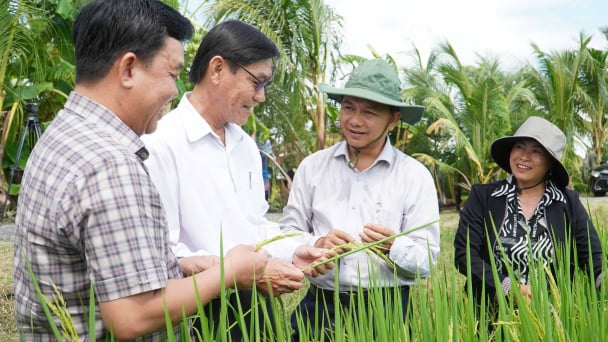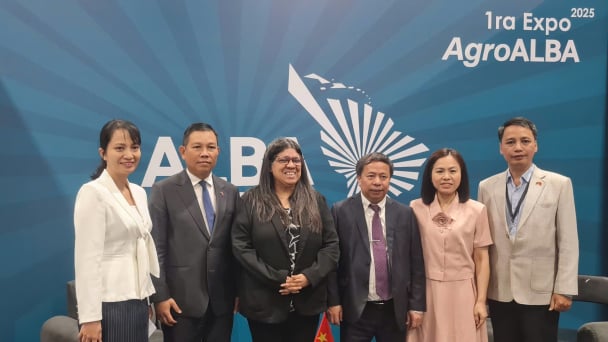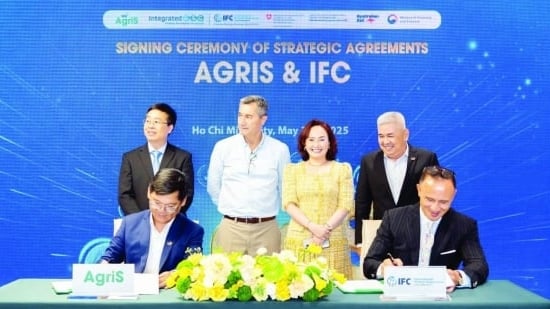June 21, 2025 | 02:48 GMT +7
June 21, 2025 | 02:48 GMT +7
Hotline: 0913.378.918
June 21, 2025 | 02:48 GMT +7
Hotline: 0913.378.918

As of September 2023, Quang Ninh province has processed and converted nearly 7 million foam buoys (reaching 99.3%). Photo: Nguyen Thanh.
Foam floats have good water buoyancy, but the average durability is only 2-3 years. In the long term, using foam buoys will majorly impact waste and the marine environment because this is an environmentally unfriendly material with a short lifespan. After only a few years of use, foam buoys decompose and break into small pieces that drift on the sea surface. When washed ashore by waves, it becomes inorganic waste, difficult to decompose, causing loss of aesthetics. When floating in the sea, it becomes a food trap, killing marine life if eaten.
Every time there is a storm, farmers risk severe damage if they grow aquaculture using foam buoys, wooden cages, or rafts. In addition, foam buoys that are damaged and drifting at sea are difficult to collect, polluting the water environment and affecting the ecosystem.
Therefore, Quang Ninh province has issued Decision No. 30/2021/QD-UBND on amending and supplementing some articles of local technical regulations on materials used to make floats in saltwater aquaculture, brackish. This is Quang Ninh's solution for managing, reviewing, closely monitoring and minimizing waste from unfriendly and unsustainable materials at sea. In particular, Quang Ninh is the first locality in the country to introduce standards for floating materials in aquaculture.
It can be said that Quang Ninh province's policy of converting foam buoys to HDPE plastic buoys is considered the right direction to protect the marine environment and help aquaculture, incredibly sustainable marine farming. Recently, removing foam buoys has received unanimous support from many people in the area.
Communes and towns also set up working groups to handle foam buoys, including militia, self-defense forces, police officers, union members, and association members, to inspect, urge, and support people in need to remove the foam float. Party Committee Secretaries and the Chairman of People's Committees of communes and towns directly went to the scene to inspect and urge Stop all unnecessary meetings to lead and direct implementation.
As of September 2023, Quang Ninh province has processed and converted nearly 7 million foam buoys (reaching 99.3%), of which localities that have completed 100% conversion include Tien Yen and Dam Ha, Localities with high conversion rates of over 95% include Van Don (99.2%), Cam Pha (99.7%), localities with medium and low conversion rates: Hai Ha (78.1%), Mong Cai (26.5%), Quang Yen (10.2%), Ha Long (46.3%). It is known that localities with low conversion rates all have a small number of foam buoys. Shortly, the remaining foam buoys will be replaced.
Particularly for Bai Tu Long National Park, aquaculture is not planned. However, there are still 25/144 households with an area of 95.3 hectares using nearly 172,000 foam buoys. According to the report of the Management Board of Bai Tu Long National Park, only 51.2% have been removed. For Ha Long City, the planned aquaculture area is 137 hectares in 5 areas on Ha Long Bay. There are currently 43 fish farming households with an area of 2 hectares. There are 4 pearl farming and fish farming companies with an area of 72.4 hectares, basically using non-plastic for farming. Notably, the unplanned aquaculture area in the southern Tuan Chau area and the bordering area between Tuan Chau and Hung Thang (44 establishments) has not been entirely resolved.

The mariculture model applying science and technology helps protect the marine environment in Quang Ninh. Photo: Nguyen Thanh.
Floating buoys and aquaculture cages made of HDPE plastic material not only have good buoyancy like foam buoys but also have a sustainable structure, are adaptable to climate change, have a lifespan of 30 - 50 years, and can withstand big waves and strong winds.
Besides, HDPE plastic material is durable, resistant to high impacts, safe for water sources, and not corroded or rusted by seawater environments. In particular, converting to aquaculture, including marine farming, using HDPE plastic is also environmentally friendly, limits the impact on the water environment, and breeds grow healthily. Besides, when integrated with science and technology applications, it will support farmers in the best way.
Mrs. Nguyen Thi Hai Binh, General Director of STP Group, said: "Up to now, STP Group has had 3 main solutions for the aquaculture industry. Firstly, at sea, we have cages for offshore that can withstand level 12 wind storms, locate coordinates on it, and, in special cases, can still find output and data using the QR code and iCheck on the cage. Second, we have the product replacement products for the foam buoy products that people used in the past, or replace drums with floating systems like houses, with HDPE buoys that are sustainable for the sea and protect the environment, replacing old float buoys".
Mr. Ngo Tat Thang, Deputy Director of the Department of Agriculture and Rural Development of Quang Ninh province, shared: "Currently, we have seen that Quang Ninh is very drastic in protecting the marine environment, starting from the stage of organizing production in the sea using buoy standards and we have also seen practical models."
In the province's development orientation to 2030 and vision to 2045, Quang Ninh focuses on key farming subjects, high-tech farming, and new technology to improve quality and output, aiming to become an aquaculture center of the North.
In 2022, the total aquaculture area in Quang Ninh province reached over 32,000 hectares; Total aquaculture output reached 87,000 tons. Of which, the total mariculture area is about 22,000 hectares with over 14,500 cages (accounting for 68.8% of the farming area); total marine aquaculture output reached more than 54,000 tons (accounting for 62.2%). In the first 6 months of 2023, the aquaculture area reached 32,100 hectares; the total aquaculture output is 52,500 tons.
Translated by Tuan Huy
/2025/06/17/3942-2-143243_548.jpg)
(VAN) Recently, in Sweden, the Secretary of the Binh Dinh Provincial Party Committee presented the Investment Registration Certificate for the 'Polyester Fabric Recycling Complex' project to SYRE Impact-AB Company.
/2025/06/12/3721-2-202745_83.jpg)
(VAN) TH made an impression at Seoul Food 2025 with its line of natural beverages, paving the way for Vietnamese food products to enter the South Korean market.

(VAN) Soc Trang's success in rice exports stems from a strategy of developing fragrant and specialty rice cultivation areas and standardizing production toward low-emission practices.
/2025/06/11/1311-5-120811_839.jpg)
(VAN) The pig farming industry is facing the challenge of comprehensive restructuring to meet requirements for quality, safety, traceability, and market expansion both domestically and for export.

(VAN) Vietnam considers participating in ALGROALBA in order to expand agricultural production, coordinate the assessment and effective exploitation potential land.
/2025/06/05/5314-1-184727_407.jpg)
(VAN) From seemingly worthless fish scales and skin, enzymes and lactic ferments can transform by-products into peptides, opening a sustainable, effective business direction and elevating Vietnamese seafood.

(VAN) TTC AgriS and IFC signed a strategic partnership to develop a sustainable agricultural value chain, aiming to achieve the Net Zero target by 2035.